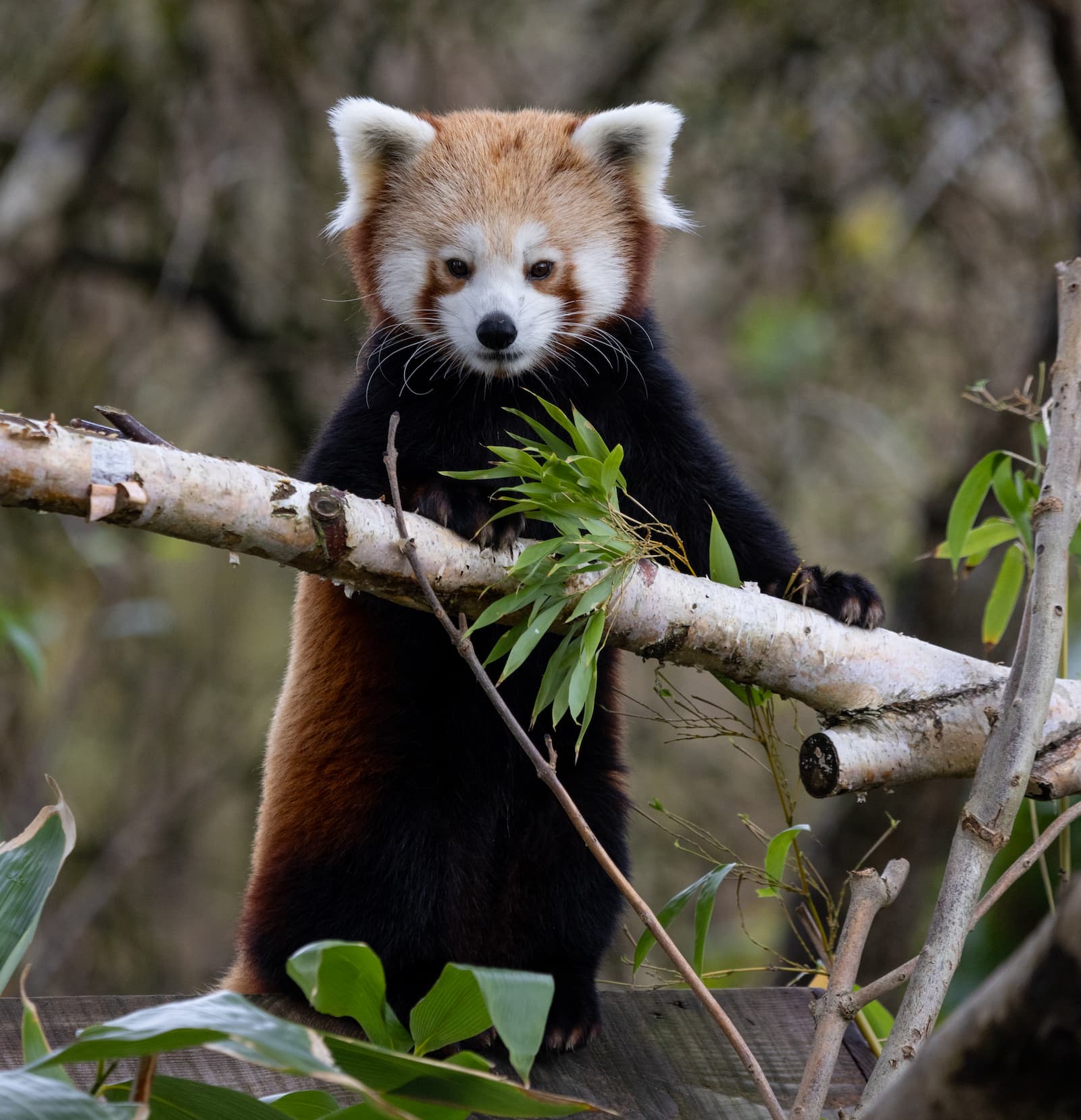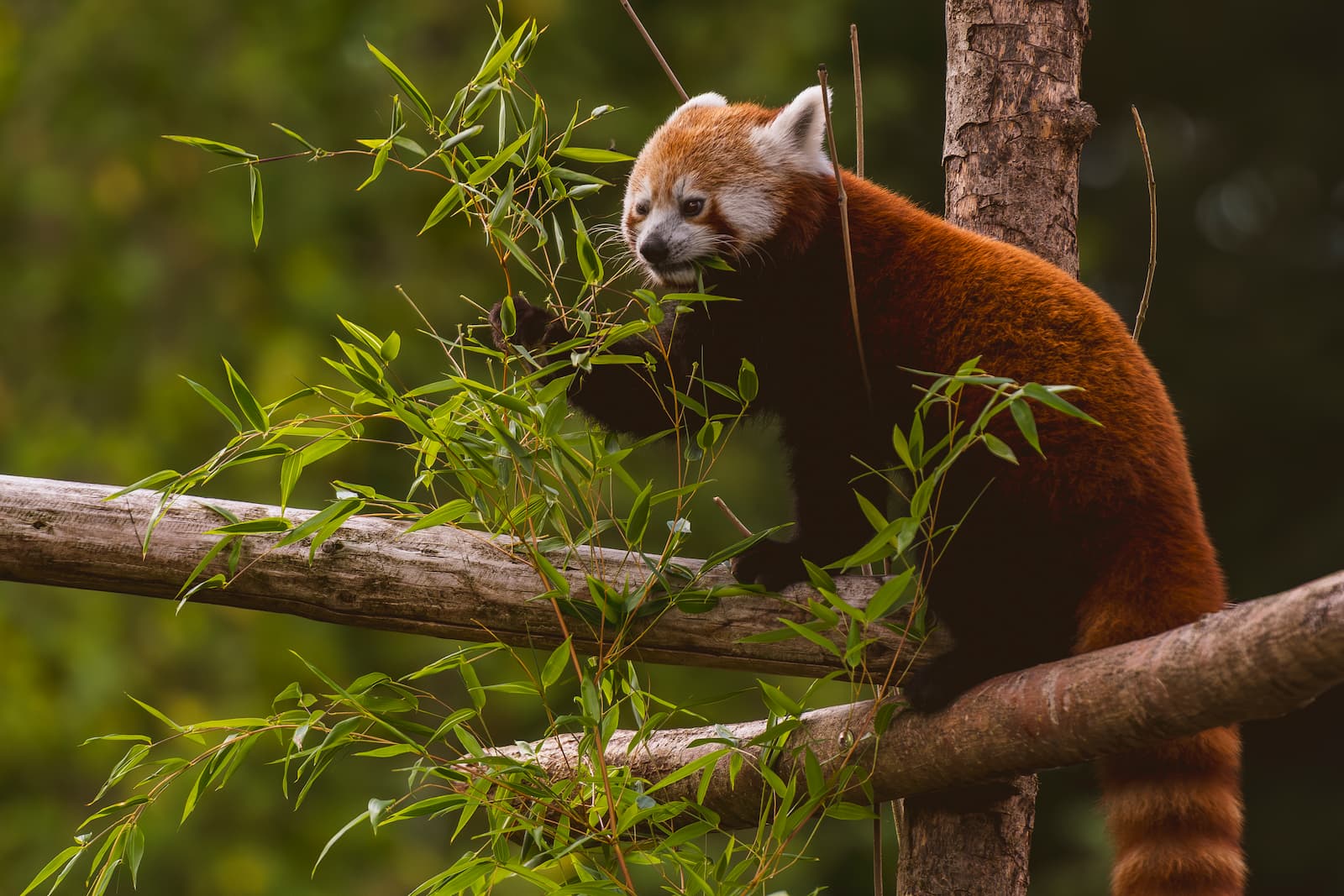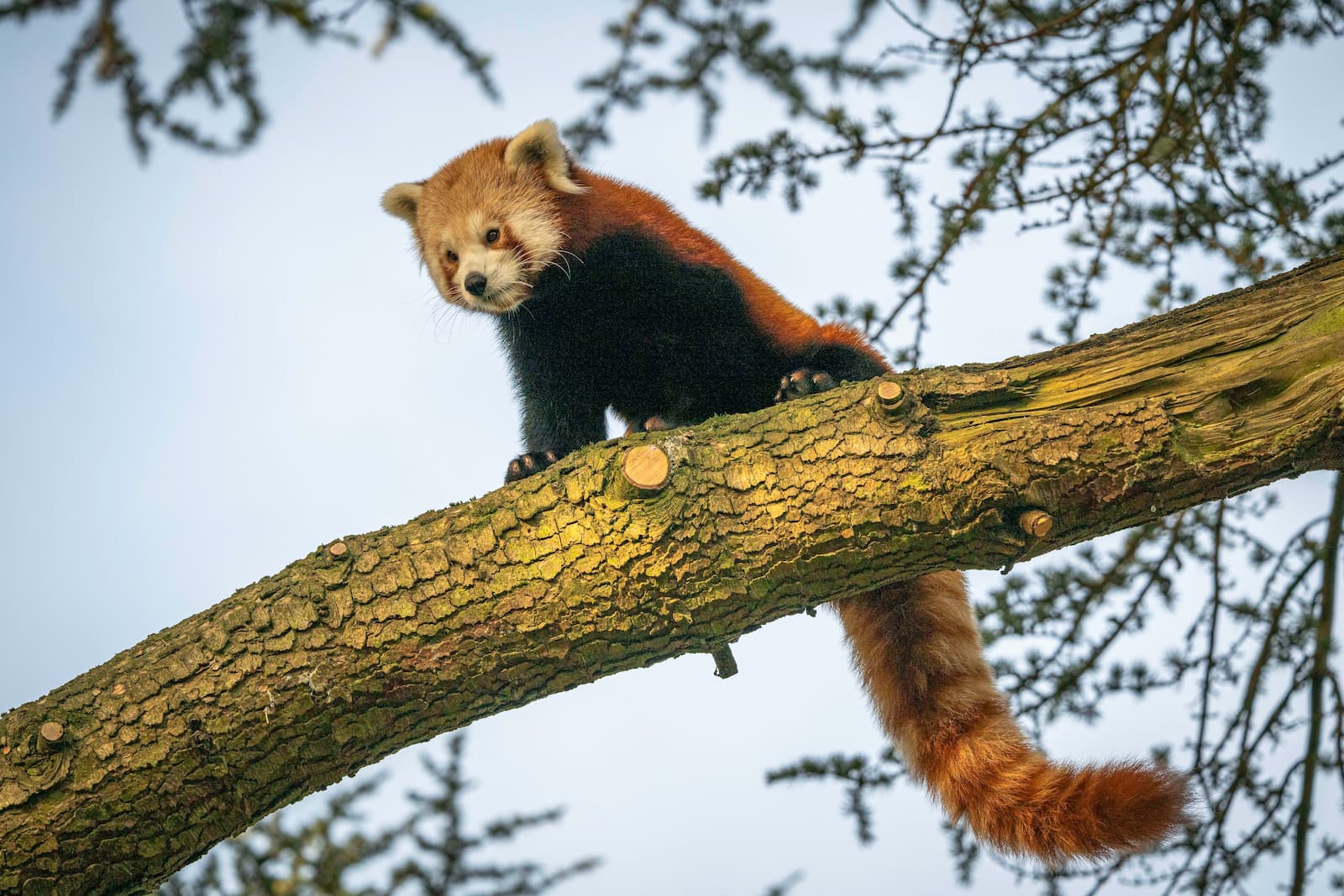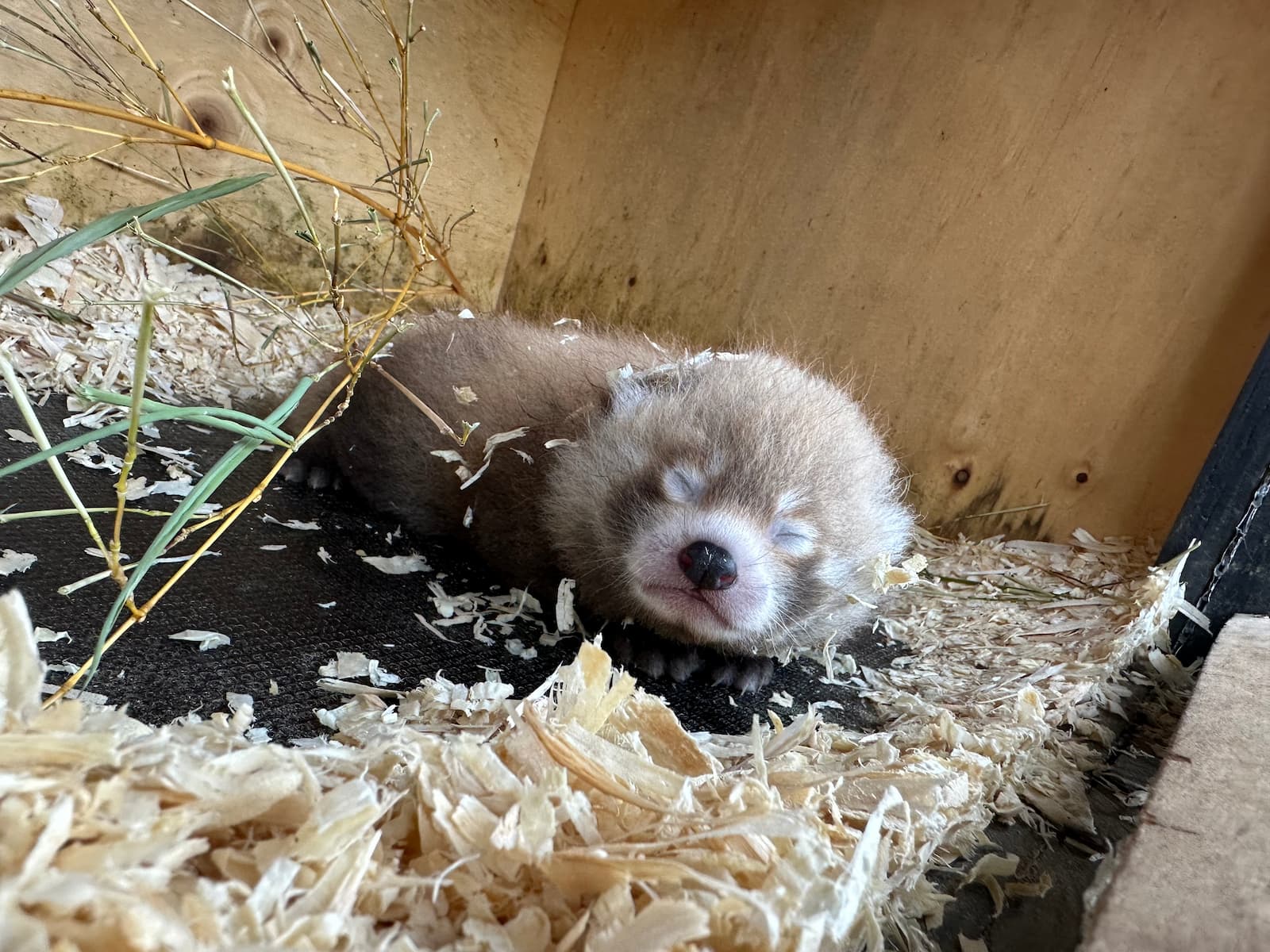7 surprising facts about red pandas
Posted on: 3 September, 2025
With their fluffy tails and playful personalities, red pandas are some of the most charming and misunderstood animals in the world.
Native to the Himalayan Mountain range through Nepal, India and China, where they are under threat from habitat loss and poaching, it’s thought there are only 2,500 left in the wild.
Far more than just cute faces, these elusive creatures are full of surprises, from their unique adaptations to mysterious behaviour. Here, we explore 7 surprising facts that reveal just how fascinating red pandas truly are and how we care for them here at Bristol Zoo Project.
 Photo credit: George Cuevas
Photo credit: George Cuevas
1. They are confused carnivores
Red pandas are classified as carnivores, but they follow a predominantly vegetarian diet, with 95% of their diet consisting of bamboo. Having descended from now-extinct members of the Ailuridae family, including ancestors such as Parailurus and Pristinailurus, this places red pandas in the mammal order Carnivora, as their closest relatives were meat-eaters. However, they have adapted to a highly specialised bamboo diet due to its abundance and a lack of competitors for this food source in their habitat in the Himalayan mountains and surrounding areas.
Red pandas still have a carnivorous digestive tract though, which is relatively short compared to herbivores and means they lack the microbes that are needed to aid in breaking down and digesting plant material. By consuming mainly bamboo and favouring the most nutritious parts of the bamboo plant, such as the young shoots and leaves that have higher protein and fibre content, they can digest it relatively quickly and survive on their mainly vegetarian diet. The rest of their diet typically consists of berries, fruits, roots, eggs, insects, and sometimes small animals.
2. They have six digits on their front paws
Red pandas have what’s often described as an extra thumb, which is an enlarged, modified wrist bone that they put to good use to climb trees and grab bamboo stems.
Giant pandas also have a pseudo-thumb, but for different reasons, which is an example of convergent evolution, the process where distantly related species independently evolve similar features to adapt to similar environments or diets. It's believed that the red panda's false thumb evolved to help it climb trees, and only later became adapted for the bamboo diet, while giant pandas evolved this virtually identical feature because of their bamboo diet.
 Photo Credit: Jon Drew
Photo Credit: Jon Drew
3. Red pandas are not giant pandas
Despite their name, red pandas are not closely related to giant pandas. While both species share a similar diet and a common name, they belong to completely different families. Giant pandas are members of the bear family, Ursidae, whereas red pandas belong to their own unique family, Ailuridae. Genetically and anatomically, red pandas are more closely related to raccoons, skunks, and weasels than to bears.
Let's also not forget that the red panda is the original panda and the name panda derives from the Nepalese name for red panda “Nigalya poonya” meaning eater of bamboo. The giant panda was discovered later and was only called a panda because of the anatomical features both species share, such as a false thumb used for grasping bamboo.
Red panda habitat and giant panda habitat overlap in Sichuan, China. Otherwise, nearly 50 percent of the red panda's habitat is in the Eastern Himalayas, including Nepal, Tibet, India, Bhutan, and Myanmar. The giant panda inhabits the six major mountain ranges in Sichuan, Shaanxi and Gansu, in China.
Red pandas are classified as endangered, whereas the giant panda is now classified as vulnerable. Both are hunted and poached for their fur; however, poaching of the giant panda has declined considerably due to strict laws and greater public awareness. Both species are also struggling to survive due to human pressures, including habitat loss and degradation, and rely on conservation interventions to ensure their survival in the wild. They are also both part of crucial breeding programmes in zoos all over the world to help bolster populations.
4. Red pandas love heights
Red pandas are tree-dwellers and great climbers with semi-retractable claws, as well as flexible ankles. In the wild, they live in temperate forests at elevations between 2,200 and 4,000 meters - that’s between six and 12 Eiffel Towers stacked on top of each other! Here they will climb high in the trees for shelter, to escape from predators, as well as sunbathe and play in the snow in winter. Along with flexible ankles, their leg bones are attached in such a way that the fibula can rotate about its axis, allowing them to turn their back feet 180 degrees, which enables them to climb down trees headfirst. Using their tails as a balance aid, they also have fur on the soles of their paws, which helps them to walk in the snow and on slippery tree branches.
Here at Bristol Zoo Project, our red pandas enjoy two tall trees, which provide lots of climbing opportunities as well as additional climbing structures and enrichment that were built by our in-house animal team.
 5. Female red pandas have unique fertility abilities
5. Female red pandas have unique fertility abilities
Red pandas tend to breed only once a year between January and March. The gestation period can be lengthy, but female red pandas can delay implantation to allow the cub or cubs a better chance of survival by being born in the warmer months of the year.
A few days before giving birth, the female gathers fallen plant material to build a nest, often choosing tree hollows as nesting sites in the wild. During the first couple of weeks after the cubs are born, she may carry them in her mouth to different nest locations as needed. For the first two weeks, the cubs remain in the nest, relying on it for safety while they spend most of their time nursing. Red panda cubs are born grayish-black in colour and begin to turn the characteristic red colour around 13–22 weeks old.
Our red pandas, Neora and Laya, had their first red panda offspring this summer at Bristol Zoo Project, named Asha, as part of our critical breeding programme to help protect the species. The birth represents a huge win for this highly threatened species, which is classified as endangered by the International Union for Conservation of Nature (IUCN).
 Photo Credit: Natalie Kent
Photo Credit: Natalie Kent
6. Red pandas are masters of disguise
Red, black, white, hints of orange and yellow, red pandas have a whole combination of colouring, and this allows them to be real masters of disguise. Creatures of camouflage, this mix helps them blend in with red moss, white lichen, and yellow-orange-red foliage of their native forest habitat, while their black bellies make them difficult to see amongst the dark tree canopy from below, which protects them from predators on the prowl.
It doesn’t stop there; red pandas also glow in the dark. The white markings on their face help guide lost cubs back to their mother at night.
Finally, the red tracks extending from their eyes to the corners of their mouths can help keep the sun out of their eyes, which is particularly important during the winter when the strong sun reflects off the snow… who would have thought it!
7. Red pandas “quack”
Red pandas are generally quiet animals, communicating through scent marking and body language, but they are also known to vocalise with noises, including growls, squeals, twitters, whistling, and a “huff-quack,” which is a soft, breathy sound, combining a huff and a quack. They use squeals and twitters for general communication, signal danger with hisses or grunts, and a “huff-quack” when they either feel excited or threatened.
Scent marking is a big part of red panda communication. They have scent glands on their feet and the base of their tails, and they rub these on surfaces to leave a trail. Through this they can mark their territory as well as inform other red pandas of their sex, age, and reproductive status.
Red pandas also use a variety of body language cues to communicate, particularly during play or when they feel threatened. Some common signals include bobbing their heads, arching their tails, and standing upright on their hind legs with raised paws to appear larger and more intimidating. They might also pounce or fix a long stare on another red panda from afar. When familiar with each other, red pandas may greet by gently touching noses without sniffing. In the case of a mother and her cub, they may raise a paw toward one another in a subtle gesture.
Photo Credit: Lorie Menard
You can visit our red pandas, male Neora, female Laya, and their new cub Asha, at Bristol Zoo Project.
Bristol Zoo Project is run by Bristol Zoological Society, a conservation and education charity. Every visit supports our mission to protect nature now and into the future here in the UK and around the world.

